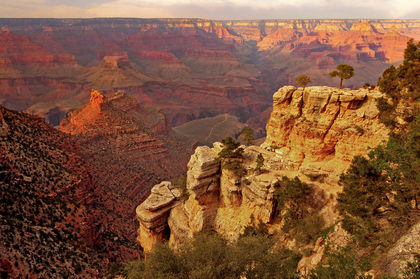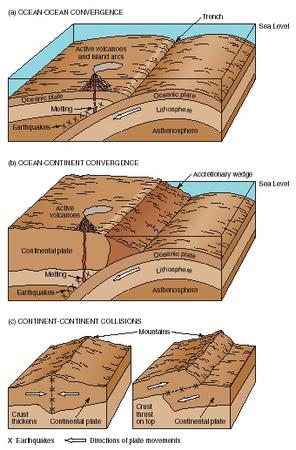Plate tectonics

Plate tectonics is the geologic theory that Earth's crust is made up of rigid plates that "float" on the surface of the planet. Tectonics comes from the Greek word meaning "builder." The movement of the plates toward or away from each other either directly or indirectly creates the major geologic features at Earth's surface.
Plate tectonics revolutionized the way geologists view Earth. Like the theory of evolution in biology, plate tectonics is the unifying concept of geology. It explains nearly all of Earth's major surface features and activities. These include faults and earthquakes, volcanoes and volcanism, mountains and mountain building, and even the origin of the continents and ocean basins.
Continental drift
Plate tectonics is a comparatively new idea. The theory of plate tectonics gained widespread acceptance only in the 1960s. About 50 years earlier, German geophysicist Alfred Wegener (1880–1930) developed a related theory known as continental drift. Wegener contended that the positions of Earth's continents are not fixed. He believed instead that they are mobile and over time drift about on Earth's surface—hence the name continental drift.
Wegener's most obvious evidence for his theory was the fact that several of the world's continents fit together like pieces in a jig-saw puzzle. Based on this, he proposed that the continents of the world were previously joined together in one large continental mass, a supercontinent he called Pangaea (pronounced pan-JEE-ah). Wegener believed that this supercontinent had subsequently broken up into the six present-day continents. However, Wegener could not provide a convincing explanation as to what moved the continents around the surface of the planet. That answer came with the theory of plate tectonics.
Plate structure
Earth's tectonic plates are rigid slabs of rock. Geologists divide the interior of Earth into layers, based on their composition (from solid to liquid).
Words to Know
Asthenosphere: Portion of the mantle beneath the lithosphere composed of partially melted material.
Convection current: Circular movement of a fluid in response to alternating heating and cooling.
Convergence: The movement of two plates toward one another.
Crust: Thin, solid outer portion of Earth.
Divergence: Separation of two plates as they move in opposing directions.
Lithosphere: Rigid uppermost section of the mantle combined with the crust.
Mantle: Thick, dense layer of rock that underlies Earth's crust.
Ocean trench: Deep depression in the seafloor, created by an oceanic plate being forced downward into the subsurface by another, overriding plate.
Plate margin: The boundaries where plates meet.
Plates: Large regions of Earth's surface, composed of the crust and uppermost mantle, which move about, forming many of Earth's major geologic surface features.
Seafloor spreading: Process in which new seafloor forms as molten rock from Earth's interior rises toward the surface, pushing the existing seafloor out of its way.
Subduction: Tectonic process that involves one plate being forced down into the mantle at an oceanic trench, where it eventually undergoes partial melting.
Transform motion: Horizontal plate movement in which one plate slides past another.
The thin outer portion of the planet is the crust. Beneath that is the mantle, which is solid near the top and "soft" or partially melted beginning at a depth of about 40 miles (65 kilometers) beneath the surface. The crust and the rigid portion of the mantle compose the lithosphere. The soft portion of the mantle is called the asthenosphere.
It is the lithosphere that is broken up into plates, which move about while floating upon the underlying asthenosphere. There are about eight major plates and several smaller ones that are in constant contact with each other. When one plate moves, it causes other plates to move. These plates have many different shapes and sizes. Some, such as the Juan de Fuca plate off the west coast of Washington State, have surface areas of a few thousand square miles. The largest, the Pacific plate, underlies most of the Pacific Ocean and covers an area of hundreds of thousands of square miles.
Plate movement
Most modern geologists believe convection currents in the asthenosphere are the driving force for plate motion. The heat energy at the center of the planet is carried to the surface by currents. As they reach the surface, the currents cool and begin to sink back toward the center. Below the crust, pressure exerted on the bottom of the plates by the convection currents helps to push the plates along. Plates move at rates of

about 1 inch (2.5 centimeters) per year. The fastest plates move more than 4 inches (10 centimeters) per year.
Plate interactions
Tectonic plates can interact in one of three ways. They can move toward one another, or converge. They can move away from one another, or diverge. Or they can slide past one another, or transform. The boundaries where plates meet are known as plate margins. The types of geologic activity that occur when two plates interact is dependent on the nature of the plate interaction and of the margins. Plate margins come in three varieties: oceanic-oceanic, continental-continental, and continental-oceanic.
Oceanic-oceanic plates. When two oceanic plates converge, one of the plates subducts or sinks underneath the other, forming a deep depression called an ocean trench. The subducted plate sinks downward into the mantle where it begins to melt. Molten rock from the melting plate rises toward the surface and forms a chain of volcanic islands, or a volcanic island arc, behind the ocean trench. When oceanic plates diverge, a ridge (mountain chain) develops and seafloor spreading occurs. Molten rock pushes up at the divergent margin, creating mountains and an expanding seafloor. Today, Europe and North America move about 3 inches (7.5 centimeters) farther apart every year as the Atlantic Ocean grows wider.
Continental-continental plates. Continental-continental convergent plates act quite differently than oceanic-oceanic plates. Continental crust is too light to be carried downward into a trench. At continental-continental convergent margins neither plate subducts. The two continental plates converge, buckle, and compress to form complex mountains ranges of great height. Convergence of this sort produced the Himalayas when the Indian-Australian plate collided with the Eurasian plate.
Continental-continental divergence causes a continent to separate into two or more smaller continents when it is ripped apart along a series of fractures. The forces of divergence literally tear a continent apart as the two or more blocks of continental crust begin slowly moving apart and magma pushes into the rift formed between them. Eventually, if the process of continental rifting continues, a new sea is born between the two continents. Rifting between the Arabian and African plates formed the Red Sea in this way.
Continental-oceanic plates. When continental and oceanic plates converge, the oceanic plate (which is denser) subducts below the edge of the continental plate. Volcanoes form as result, but in this setting, the chain of volcanoes forms on the continental crust. This volcanic mountain chain, known as a volcanic arc, is usually several hundred miles inland

from the plate margin. The Andes Mountains of South America and the Cascade Mountains of North America are examples of volcanic arcs. No continental-oceanic divergent margins exist today. They are unlikely to form and would quickly become oceanic-oceanic divergent margins as seafloor spreading occurred.
Transform motion. In addition to convergence and divergence, transform motion may occur along plate margins. Transform margins are less spectacular than convergent and divergent ones, and the type of plates involved is really of no significance. As two rock plates slide past one another at a margin, a crack or fault develops. The energy generated by the movement is often released in the form of an earthquake. The best known example of a transform plate margin is the San Andreas Fault in California, where the Pacific and North American plates are in contact.
[ See also Earthquake ; Earth's interior ; Fault ; Geologic map ; Ocean ; Volcano ]
can i know more about convergen plate tectonic?and also all about tectonic plate?wilson cycle?
can oceanic plates slide past continental plates?
my teacher says that it can't. but isn't the pacific plate an oceanic plate? i'm confused about the san andreas fault:(
THANK YOU
thank for your help
Thanks,
Brandon
Very well presentend.!(y)
it helped me with my homework for science.!!!
ll my questions were in the
passage .
Slab Pull- process in which the leading edge of the sub-ducting plate pulls the plate along with it.
Ridge Push- process where rising molten rock pushes a spreading ridge up higher than the rest of the ocean floor
RESULT IN THE THE MOVEMENT OF EARTH`S PLATES?
i need your help...
The theory of plate tectonics has done for geology what Charles Darwin's theory of evolution did for biology. It provides geology with a comprehensive theory that explains "how the Earth works." The theory was formulated in the 1960s and 1970s as new information was obtained about the nature of the ocean floor, Earth's ancient magnetism, the distribution of volcanoes and earthquakes, the flow of heat from Earth's interior, and the worldwide distribution of plant and animal fossils.